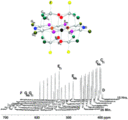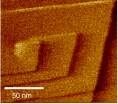
Abstract Density functional electronic structure calculations are used to compute the equilibrium constant (the isotope fractionation factor) for 26Mg/24Mg and 44Ca/40Ca isotope exchange between carbonate minerals and uncomplexed divalent aquo ions. The most reliable calculations at the B3LYP/6-311++G(2d,2p) level predict equilibrium constants K, reported as 103ln(K) at 25 deg. C, of -5.3, -1.1, and +1.2 for 26Mg/24Mg exchange between calcite (CaCO3), magnesite (MgCO3), and dolomite (Ca0.5Mg0.5CO3), respectively, and Mg2+(aq), with positive values indicating enrichment of the heavy isotope in the mineral phase. For 44Ca/40Ca exchange between calcite and Ca2+(aq) at 25 deg. C, the calculations predict values of +1.5 for Ca2+(aq) in six-fold coordination and +4.1 for Ca2+(aq) in seven-fold coordination. We find that the reduced partition function ratios can be reliably computed from systems as small as M(CO3)610- and M(H2O)62+ embedded in a set of fixed atoms representing the 2nd shell (and greater) coordination environment. We find that the aqueous cluster representing the aquo ion is much more sensitive to improvements in the basis set than the calculations on the mineral systems, and that fractionation factors should be computed using the best possible basis set for the aquo complex, even if the reduced partition function ratio calculated with the same basis set is not available for the mineral system. The new calculations show that the previous discrepancies between theory and experiment for Fe3+-hematite and Fe2+-siderite fractionations arise from an insufficiently accurate reduced partition function ratio for the Fe3+(aq) and Fe2+(aq) species.
Rustad, J.R., Casey, W. H., Yin, Q.-Z., Bylaska, E. J., Felmy, A. R., Bogatko, S. A., Jackson, V. E., Dixon, D. A. Isotopic Fractionation of Mg2+(aq), Ca2+(aq), and Fe2+(aq) with Carbonate Minerals Geochim. Cosmochim. Acta, 2010, 47(22), 6301-6323













